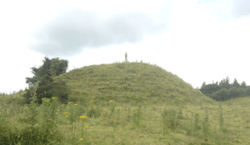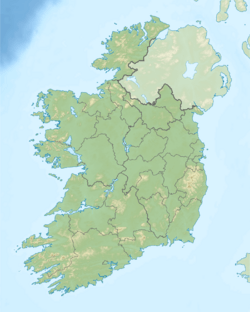Granard Motte facts for kids
Quick facts for kids Granard Motte |
|
|---|---|
| Móta Ghránaird | |
| Church Street, Granard, County Longford in Ireland | |
 |
|
| Coordinates | 53°46′32″N 7°30′02″W / 53.775535°N 7.500468°W |
| Site history | |
| Built | 1199 |
| Materials | earth |
Granard Motte is what's left of an old motte-and-bailey castle. It's also a National Monument in Granard, County Longford, Ireland. A motte-and-bailey castle was a type of castle built from earth and wood. It had a big mound (the motte) with a tower on top, and a fenced-off area below (the bailey).
Where is Granard Motte?
Granard Motte (also known as National Monument Ref No LF010-080001) is found in the town of Granard. It's about 5.7 kilometers (3.5 miles) west of Lough Kinale. This historic site looks out over the Inny valley.
Standing at 163 meters (535 feet) high, it's the tallest motte in all of Ireland! The earthworks are about 220 meters (720 feet) southwest of Granard town. Its high spot offers amazing views of the countryside around it.
History of Granard Motte
The Granard motte earthworks were built around the year 1199. A Norman knight named Richard de Tuit had it built. It was actually put on top of an older hillfort that was already there. This site also has links to a local family group called the Ó Fearghail clan (Farrell).
It seems this castle was meant to be a border fort. It protected the northwest edge of the Anglo-Norman area of Meath. It was also built to keep the O'Reilly family of South Breffny in check. In 1210, King John of England even stayed here. This was during his military trip against Hugh de Lacy.
Later, the site became known as Rath Granard. Some historians believe it was where the O'Farrell chiefs were officially made leaders. One important family member, Sean Ó Fearghail, who was Chief of Annaly, is thought to have died here in 1475. He was buried nearby at Abbeylara.
The top of the motte is quite flat. It measures about 27 meters (89 feet) from north-northwest to south-southeast. It is also about 22 meters (72 feet) from east-northeast to west-southwest. This flat area is about 4 meters (13 feet) higher than the bailey below. A special survey marker is also located here. In 1932, a statue of Saint Patrick was placed on top of the motte. This was to celebrate 1500 years since his mission to Ireland.
Many old stories are told about the hollow inside the motte. Some say a hidden castle is inside, or maybe a treasure of gold. Others think it was once a place to store grain. In May 2017, the motte got a lot of attention. A large hole, about a meter (3 feet) wide, was found dug into its side. This damage needed experts from the National Monuments Service to check it. The Office of Public Works then had to repair it.
What Granard Motte Looks Like
The Motte is a large, round, flat-topped mound made of earth. On top of it, there would have been a wooden tower. This tower would have been surrounded by a palisade, which is a strong fence made of pointed wooden stakes.
Around the base of the motte was a U-shaped bailey. This was an enclosed area also protected by a ditch and a palisade. The site was very well protected, except on its southern side. This side seemed to be guarded only by a deep trench on the top. The round mound is about 9 meters (30 feet) high. It has a deep ditch, called a fosse, on its northeastern side. A D-shaped bailey is on the southwest side.
In 1925, a small cave-like structure, called a grotto, was built into the north side of the monument. During this work, a lot of stone was removed, even using explosives. From the west-southwest to the north and east-northeast, the base of the motte is surrounded by a wide, deep, steep-sided ditch cut into the rock. This ditch is about 10.5 meters (34 feet) wide and 3.5 meters (11 feet) deep. There is also a wide, high, steep bank outside this ditch. This bank is about 8 meters (26 feet) wide and 2.9 meters (9.5 feet) high.
The bailey area is marked by what's left of an inner bank of earth and stone. It also has a wide, deep ditch (about 12 meters or 39 feet wide) and a wide, high outer bank (about 10 meters or 33 feet wide and 2 meters or 6.5 feet high). You can still see small parts of a later castle on the southeast side of the motte. An old medieval church and graveyard are located about 100 meters (330 feet) to the north.


